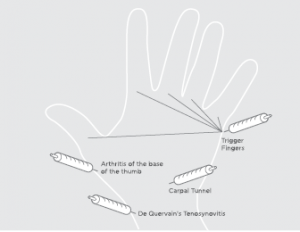Steroid Injections
INTRODUCTION
Steroid, or “cortisone”, injections are a very common treatment for a wide range of painful or inflammatory conditions around the hand, wrist and elbow. Unlike pills, injected steroids deliver a high concentration of the medicine directly to the area of concern and minimize the side effects to the body as a whole.
The steroids that are used for injection are just one member of a large family of compounds known are hormones. The hormones produced naturally in the body regulate many biological functions such as growth, metabolism, inflammation and reaction to stress or injury. The synthetically produced steroids used for injections (e.g. betamethasone, triamcinolone) are in a group called glucocorticoids. Like their naturally occurring counterparts, this group has a number of functions including regulation of inflammation and the immune system. These the steroids should not be confused with anabolic steroids that have been misused for performance enhancement in sports. Anabolic steroids mimic the action of testosterone and are not generally used for musculoskeletal problems.
Two of the most common conditions treated by steroid injection are tendonitis and arthritis. In the wrist and hand, most of the tendons pass through tunnels (tendon sheathes) that keep them tracking properly as they move. When a tendon is injured or overused, it often becomes swollen, making it more difficult to glide through its narrow tunnel. This results in pain and limitation of motion. A steroid injection can quickly reduce the swelling and associated pain, sometimes on a permanent basis.
In arthritic conditions, the protective tissue at the ends of the bones (articular cartilage) is reduced or lost, allowing bone to bone contact within the joint. This triggers inflammation, with resulting pain, stiffness and swelling. A steroid injection in the joint can quickly reduce the inflammation, allowing resumption of activity with comfort. Although the effect is temporary, since the underlying cartilage loss remains, the benefits can often last for months at a time.
Like most medications, steroid injections do have potential side effects. The most common is a temporary flare of pain directly in the site of injection. Though uncomfortable, it predictably resolves over a period of a few days. Less common side effects include lightening of the skin color or thinning of the fat at the site of injection. These effects are not dangerous, and will often reverse over time. Extremely rare complications include infection and tendon ruptures.
Some common misunderstandings exist regarding steroid injections. One popular myth is that a person can only receive three injections in one location in their lifetime. Although the frequency of injections is often kept to three or less a year, there is no specific lifetime limit. Injections are often stopped after three attempts because they are no longer effective, not due to safety concerns. Another common myth is that steroid injections cause arthritis. Although increased activity due to pain relief may play some role, the worsening of arthritis is largely due to the natural progression of the disease rather than to steroid exposure.
Steroid injections are a safe and effective treatment alternative for a variety of painful conditions. You can have a detailed discussion with your hand surgeon or other health care professional to determine whether or not it is right for you.

